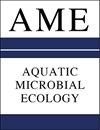Changes in microbial communities during seawater pre-treatment within a desalination plant
IF 1.1
4区 环境科学与生态学
Q3 ECOLOGY
引用次数: 0
Abstract
We analysed prokaryotic and eukaryotic communities across the seawater pre-treatment system of Penneshaw (Kangaroo Island, South Australia) desalination plant, using 16S and 18S rRNA gene sequencing. The richness of operational taxonomic units increased downstream of the pre-treatment system (reverse osmosis feedwater) compared to raw seawater for Archaea, while it decreased for bacteria and protists. Overall, the reverse osmosis feedwater was found to be enriched in ammonia-oxidising bacteria and Archaea compared to raw seawater, and also contained greater proportions of taxa typically observed in aquatic biofilms and/or within other water treatment systems. Although the microbial load was reduced by the pre-treatment system, the increase in proportion of biofilm-associated microbes suggests the presence of active microbial communities within multimedia filters and other parts of the pre-treatment system that might increase biofouling risks.海水淡化厂海水预处理过程中微生物群落的变化
利用16S和18S rRNA基因测序技术,对Penneshaw(袋鼠岛,南澳大利亚)海水淡化厂海水预处理系统中的原核和真核生物群落进行了分析。与原水相比,预处理系统(反渗透给水)下游古菌的操作分类单位丰富度增加,而细菌和原生生物的丰富度则减少。总的来说,与原始海水相比,反渗透给水富含氨氧化细菌和古细菌,并且在水生生物膜和/或其他水处理系统中也含有更大比例的典型分类群。虽然预处理系统减少了微生物负荷,但生物膜相关微生物比例的增加表明,在多媒体过滤器和预处理系统的其他部分中存在活跃的微生物群落,可能会增加生物污染风险。
本文章由计算机程序翻译,如有差异,请以英文原文为准。
求助全文
约1分钟内获得全文
求助全文
来源期刊

Aquatic Microbial Ecology
环境科学-海洋与淡水生物学
CiteScore
3.30
自引率
0.00%
发文量
8
审稿时长
3.0 months
期刊介绍:
AME is international and interdisciplinary. It presents rigorously refereed and carefully selected Research Articles, Reviews and Notes, as well as Comments/Reply Comments (for details see AME 27:209), Opinion Pieces (previously called ''As I See It'') and AME Specials. For details consult the Guidelines for Authors. Papers may be concerned with:
Tolerances and responses of microorganisms to variations in abiotic and biotic components of their environment; microbial life under extreme environmental conditions (climate, temperature, pressure, osmolarity, redox, etc.).
Role of aquatic microorganisms in the production, transformation and decomposition of organic matter; flow patterns of energy and matter as these pass through microorganisms; population dynamics; trophic interrelationships; modelling, both theoretical and via computer simulation, of individual microorganisms and microbial populations; biodiversity.
Absorption and transformation of inorganic material; synthesis and transformation of organic material (autotrophic and heterotrophic); non-genetic and genetic adaptation; behaviour; molecular microbial ecology; symbioses.
 求助内容:
求助内容: 应助结果提醒方式:
应助结果提醒方式:


